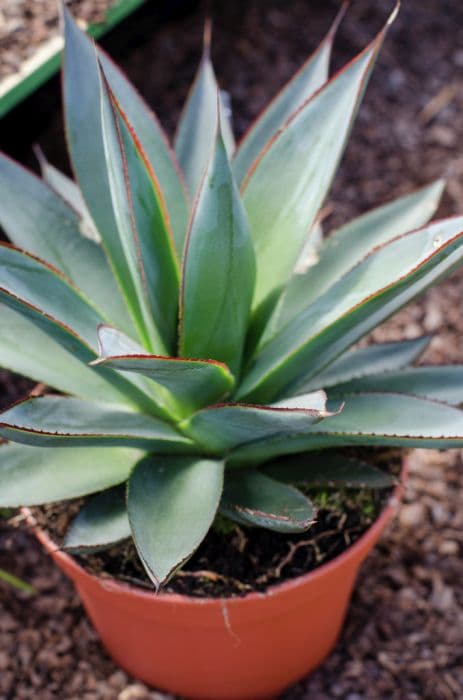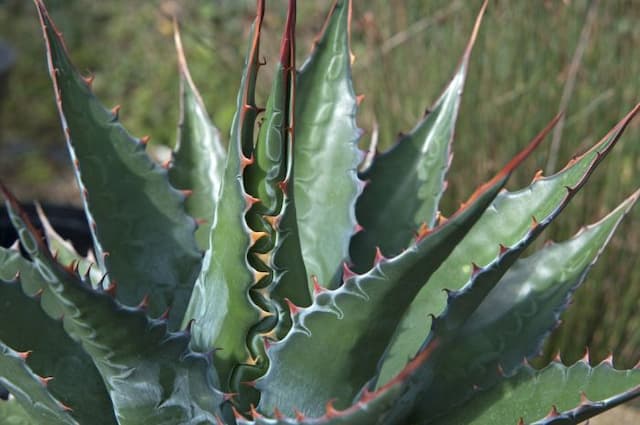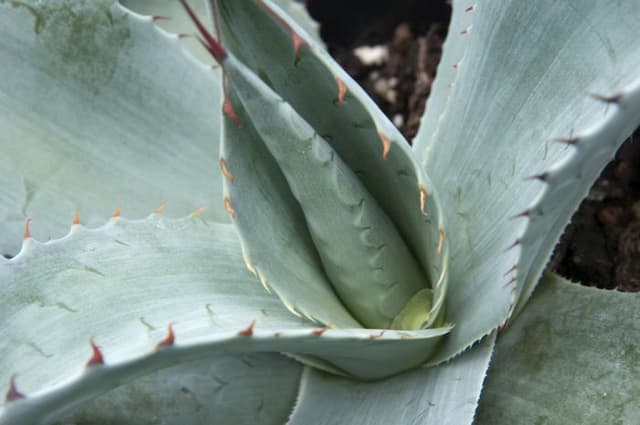African Spear Sansevieria cylindrica

ABOUT
Sansevieria cylindrica, commonly known as African Spear or Cylindrical Snake Plant, has a striking and unique appearance that sets it apart from other indoor plants. It features long, cylindrical leaves that grow upright and have a smooth, rounded appearance, resembling spears or rods. The leaves are dark green with lighter green, and sometimes whitish, horizontal bands or streaks wrapping around them. At times, the plant leaves display a slight spiral twist, which adds an extra touch of visual interest. The surface of the leaves is waxy and has a leathery texture. Sansevieria cylindrica may occasionally produce a flower spike from within the cluster of leaves, which will result in a spray of white or cream blooms that have a sweet fragrance. The blooms are quite an unexpected and infrequent surprise since the plant is primarily known for its foliage rather than its flowers. The base of the African Spear is typically dense, with leaves emerging from a central point, giving the plant a full and robust look. Even with its striking and bold leaf structure, the overall impression it imparts is one of elegance and simplicity, making it a popular choice for adding a touch of greenery to both modern and traditional décors.
About this plant
 Names
NamesSynonyms
African Spear, Cylindrical Snake Plant, Spear Sansevieria, Skyline Spear Sansevieria, Saint Bárbara Sword.
Common names
Dracaena angolensis, Sansevieria cylindrica var. patula, Sansevieria livingstoniae, Sansevieria zeylanica var. patula.
 Characteristics
CharacteristicsLife cycle
Perennials
Foliage type
Evergreen
Color of leaves
Green
Flower color
White
Height
2-3 feet (60-90 cm)
Spread
2 feet (60 cm)
Plant type
Succulent
Hardiness zones
9
Native area
Angola
Benefits
 General Benefits
General Benefits- Low Maintenance: Sansevieria cylindrica is known for being a hardy plant that requires minimal care, making it ideal for busy individuals or those who are not experienced in gardening.
- Drought Tolerant: This plant has the ability to survive with little water, suitable for arid climates or periods of neglect.
- Aesthetic Appeal: With its striking cylindrical leaves, Sansevieria cylindrica can serve as a focal point or complement interior decor, contributing to an aesthetically pleasing environment.
- Improves Humidity: By releasing moisture into the air, this plant can help maintain comfortable indoor humidity levels, which is beneficial during dry seasons or in air-conditioned rooms.
- Tolerance to Low Light: It can thrive in low light conditions, making it ideal for areas within homes or offices that don't receive a lot of natural sunlight.
- Growth Pattern: Its upwards growth pattern makes it a space-efficient plant that fits well in small spaces or as part of a compact garden arrangement.
- Non-toxic to Pets: Unlike some other houseplants, Sansevieria cylindrica is non-toxic to cats and dogs, which is important for pet owners.
- Longevity: It is a long-living plant that, with proper care, can be a long-term feature in one's living space or garden.
 Medical Properties
Medical PropertiesThis plant is not used for medical purposes.
 Air-purifying Qualities
Air-purifying QualitiesThis plant is not specifically known for air purifying qualities.
 Other Uses
Other Uses- Sansevieria cylindrica can be used as a protective charm in some cultures, believed to ward off evil spirits and bad luck when placed in the home.
- The stiff and upright leaves of this plant make it ideal for creating living green sculptures or art installations in public spaces or gardens.
- In some regions, the fibrous nature of the plant's leaves is harnessed to make strong ropes and twines for various uses.
- African Spear can be used in educational settings to teach principles of xeriscaping and drought-resistant gardening practices.
- This plant's ability to thrive with minimal care makes it an ideal gift for offices or homes to symbolize resilience and endurance.
- The straight, rod-like leaves of African Spear can sometimes be incorporated into traditional crafts, such as basket weaving or as natural knitting needles.
- Sansevieria cylindrica, with its unique appearance, can be used as a natural room divider or privacy screen in open-plan living spaces or studios.
- In certain communities, the leaves of African Spear are used in the preparation of food, where they can serve as biodegradable skewers for grilling.
- Due to its upright growth habit, it is sometimes used as a living support for climbing plants that require a host to latch onto.
- The unique form and structural integrity of the plant's leaves make it a favored choice for incorporating into avant-garde fashion and sustainable textile designs.
Interesting Facts
 Feng Shui
Feng ShuiSansevieria, commonly known as Snake Plant, can be used in Feng Shui to introduce wood energy, which enhances growth and vitality. It can also purify the air and remove toxins, which is seen as positive Chi. It's often placed in areas that need an energetic lift or where air quality needs improvement, such as in the home or office.
 Zodiac Sign Compitability
Zodiac Sign CompitabilityThe Snake Plant is not used in astrology practice.
 Plant Symbolism
Plant Symbolism- Longevity: Sansevieria cylindrica, commonly known as African Spear, is known for its durability and ability to survive in harsh conditions, symbolizing long life.
- Strength: The stiff, upright nature of its leaves gives the impression of resilience and represents inner strength.
- Tenacity: Its ability to survive with minimal care and in low-light conditions represents tenacity and the ability to overcome challenging situations.
- Cleanliness: The African Spear is believed to purify the air by removing toxins, symbolizing cleanliness and purity.
- Good Luck: Some cultures believe that having this plant in the home brings good luck and wards off negative energy.
- Architectural: Due to its structural look, it is also associated with beauty in simplicity and modern architectural aesthetics.
 Water
WaterThe Snake Plant, commonly known as Sansevieria cylindrica, requires watering approximately every 2-3 weeks. However, this schedule can vary depending on the humidity and temperature of your environment. Always check the soil for dryness before watering; the top inch of soil should be dry to the touch. When you do water, provide a thorough soaking until water runs out of the drainage holes. For a standard pot size, using up to 8 ounces of water should be sufficient. Ensure to empty the saucer under the pot after watering to prevent root rot.
 Light
LightThe Snake Plant, commonly known as Sansevieria cylindrica, thrives in bright indirect sunlight but can also adapt to low light conditions. The best spot for this plant is near a north or east-facing window where it receives plenty of light without being exposed to the harsh direct afternoon sun. However, they are versatile and can tolerate some direct sun or artificial light as well.
 Temperature
TemperatureThe Snake Plant, or Sansevieria cylindrica, prefers temperatures between 70-90°F during the day and should not be exposed to temperatures below 55°F, as it is not cold-hardy. The ideal temperature would be a consistent range between 70°F and 80°F. This plant can withstand a variety of temperature fluctuations but thrives in warmer environments.
 Pruning
PruningPruning of the Snake Plant, or Sansevieria cylindrica, is generally infrequent and is mainly done to remove any damaged or yellow leaves to maintain the plant's appearance. Use clean, sharp scissors or pruning shears and cut the leaf all the way back to the soil level. The best time for pruning is during the growing season, spring through summer. Pruning helps to encourage new growth and can be done as needed, usually no more than once a year.
 Cleaning
CleaningAs needed
 Soil
SoilThe best soil mix for the African Spear should be well-draining with a mix of potting soil, sand, and perlite or pumice. The ideal pH range is between 6.0 and 7.0.
 Repotting
RepottingAfrican Spear plants generally need repotting every 2-3 years or when they become root-bound.
 Humidity & Misting
Humidity & MistingAfrican Spear thrives in average room humidity levels but can tolerate dry air conditions.
 Suitable locations
Suitable locationsIndoor
Place African Spear in bright, indirect light inside.
Outdoor
Grow African Spear in shaded areas with indirect sunlight outside.
Hardiness zone
9-11 USDA
 Life cycle
Life cycleSansevieria cylindrica, commonly known as African Spear, starts its life cycle when its seeds germinate in warm and slightly moist soil conditions. The seedlings then develop into juvenile plants with upright cylindrical leaves, a stage characterized by rapid vegetative growth as the plant establishes its root system. As it matures, the African Spear enters a relatively slow-growing phase where it focuses energy on thickening its leaves and strengthening its base, which can store water and nutrients for drought periods. Once it reaches maturity, the plant may produce flower spikes that are usually creamy-white and have a sweet fragrance, typically blooming at night. After pollination, these flowers can produce small orange berries that contain seeds, completing the reproductive cycle. Over time, the mother plant may also give rise to new side shoot offsets or "pups," allowing for asexual reproduction through division.
 Propogation
PropogationPropogation time
Spring-Early Summer
Propogation: Sansevieria cylindrica, commonly known as the African Spear plant, is typically best propagated during the warmer parts of the year, spring and summer, when conditions promote active growth. The most popular method of propagation for the African Spear plant is by dividing the rhizomes. This can be done by taking the plant out of its pot and carefully separating the rhizome clusters, ensuring each new section has at least one healthy leaf. Once separated, each section should be planted in its own pot filled with a well-draining potting mix and watered lightly. It's crucial to let the cuttings dry for a day before planting to avoid rot. Over the course of a few weeks, with proper warmth and light, the divisions will establish roots and begin to grow into new, independent plants.









